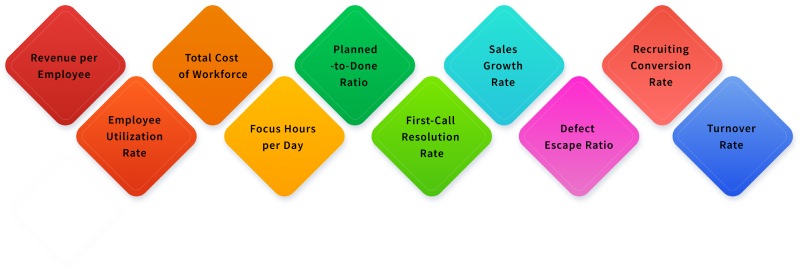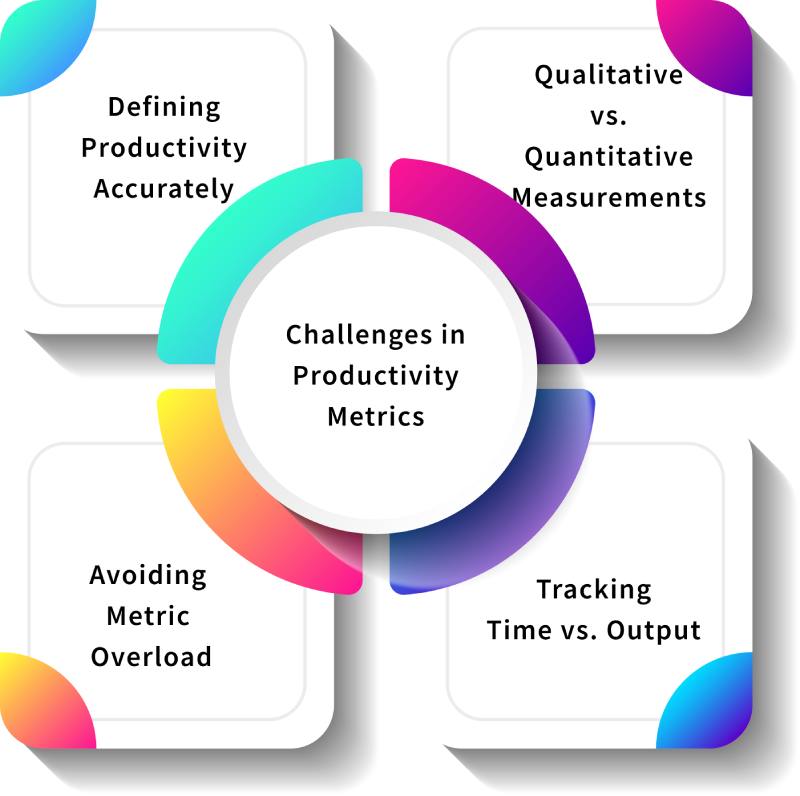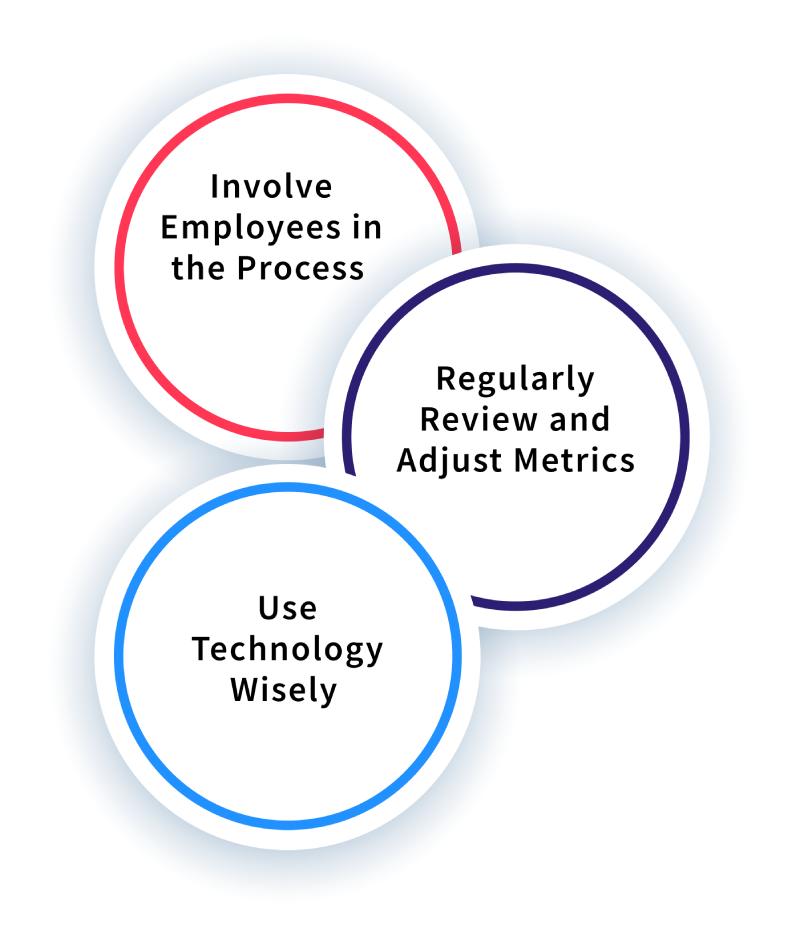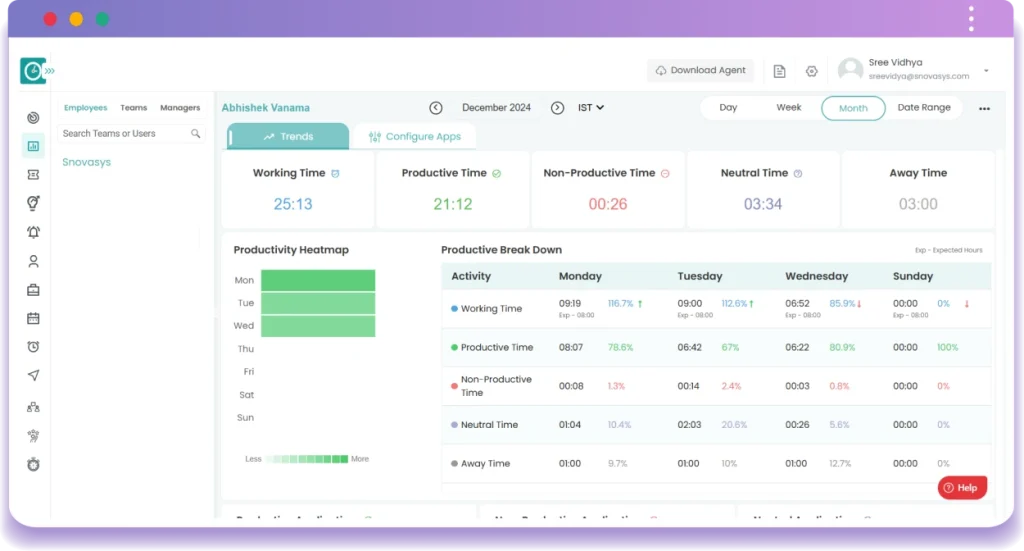Is your team’s productivity tracking as effective as it should be? When businesses fail to use precise productivity metrics, they risk draining resources and losing competitive ground. Without the right measures, it’s hard to drive meaningful progress. The good news? There are proven metrics that can transform how you track productivity , and we’ll show you exactly how they work.
What are Productivity Metrics?
Productivity metrics are specific measurements that help assess how effectively resources are utilized to achieve desired outcomes. It determines performance by breaking down the diverse areas of the relationship between outputs and inputs such as the effectiveness of human resources, project completion rates, and operational processes. This affords an organization a view of its effectiveness, bottlenecks, and strategies needed for improvement.
This formula can be adapted to fit different contexts, such as measuring output per hour worked or revenue generated per employee. The choice of metrics should align with the organization’s specific goals and operational context.
Productivity = Total Output / Total Input
10 Essential Productivity Metrics and KPIs to Measure Success
“If you can’t measure it, you can’t improve it.” – Lord Kelvin. Effective productivity relies on clear metrics to guide improvement. In this section, we’ll dive into 10 essential productivity metrics and KPIs that help you measure progress, optimize performance, and ensure success.

1. Revenue per Employee
Revenue per employee stands out as a key metric for business performance. It gives information about how effectively the firm generates income over the number of employees. Businesses can get a better view of productivity by taking the total revenue and dividing it by the number of employees. This shows how much revenue each employee contributes.
To calculate revenue per employee, you take a company’s annual revenue and divide it by the number of employees. Suppose a company brings $5 million in annual revenue using 50 employees, then this company has revenue per employee of $100,000.
Tracking this metric is very essential to enable companies to identify productivity trends, their staffing needs, and assess their workforce efficiency. It also forms an invaluable benchmark in the industry so that companies can see their position relative to their competitors. The higher revenue per employee reveals more streamlined processes, a much more competent workforce, or a product that drives profitability.
Revenue per Employee= Total Revenue / Number of Employees
2. Employee Utilization Rate
Employee utilization rate is the percentage of an employee’s available work hours spent on productive, billable tasks rather than administrative or non-billable tasks. It is one of the most popular metrics used by companies with project-based client work or billing such as consulting, marketing, and IT services.
The utilization rate can be calculated by dividing the billable hours by the total available hours. For example, assume an employee puts in 40 hours a week, with 30 of them billable. That means that an employee’s utilization rate is 75%. A utilization rate helps an employer understand how effectively employees are using the workforce’s time and highlights opportunities for process improvement or workload adjustments.
A high rate of utilization may point out that the employees are doing the right things that generate value, but if the rate is too high, then employees burnt out. Therefore, this metric brings out the maximum productivity without overloading the workers.
Employee Utilization Rate= (Billable Hours/ Total Available Hours) X 100
3. Total Cost of Workforce (TCOW)
An important metric is the Total Cost of Workforce (TCOW), covering the employee’s cost to an organization, including wages, benefits, training, taxes, and other related costs. This metric will allow organizations to have an explicit view of their investment in the workforce relative to overall operating costs. Companies calculate TCOW by adding all the staff-related costs over some time to make informed decisions on budgeting and workforce expansion.
Analyzing TCOW helps leaders determine if their investments in talent are translating into productivity and profitability. And it also throws open opportunities to optimize labor costs without compromising on performance levels. Effective management of TCOW is essential for companies to make the best return on their human capital investment.
TCOW = Total Salaries + Benefits + Training Costs
4. Focus Hours per Day
Another productivity measure is the daily focus hours, which measures how much uninterrupted, deep-focus time an employee has each day. Focus hours measure when an employee can work free from distractions, leading to increased quality of output and even quicker completion of complex tasks.
This metric can be recorded using time-tracking software or through self-reported data on how much time employees spend on tasks without distractions. Tracking focus hours helps reveal blind spots, such as productivity barriers, and allows organizations to enhance employee efficiency. To reduce errors, businesses should minimize interruptions and foster a culture that supports deep work. This approach ultimately boosts overall productivity.
Focus Hours per Day = Total Work Hours − Distractions
5. Planned-to-Done Ratio
The planned-to-done ratio compares planned versus completed tasks or projects within a given time frame. This is a widespread metric that is used in project management to measure efficiency and the precision of implementation.
This planned-to-done ratio is obtained by taking the number of tasks accomplished dividing it by the number planned, and then multiplying by 100 for the percentage.
For instance, if a team had planned a list of 30 tasks but could only accomplish 24, the ratio would be 80%. This will enable teams to know whether their planning process is realistic or whether they are using resources appropriately.
High planned-to-done ratios suggest adequate project management and effective execution capacity, but low ratios suggest potential issues in the accuracy of plans or inappropriate usage of resources. The metric is essential for identifying where adjustments in planning, communication, or support might be needed.
Planned−to−Done Ratio = (Tasks Completed Tasks Planned) X 100
6. First-Call Resolution Rate (Customer Service)
The first-call resolution rate is a customer service metric, that measures the percentage of calls that are resolved during the first contact with the customer. This metric reflects the efficiency and effectiveness of customer service teams in resolving issues quickly, leading to improved customer satisfaction.
This can be measured by finding the number of issues that were resolved on the first contact dividing it by total contacts and multiplying by 100.
A high level of first-contact resolution rate shows that the team knows how to handle inquiries most effectively, thus making quicker service and happier customers. It also gives an opportunity to reduce repeat contacts, free up resource utilization, and increase overall efficiency.
First−Call Resolution Rate = (Issues Resolved on First Call / Total Customer Issues) X 100
7. Sales Growth Rate
The sales growth rate is the measure of how much sales revenues have increased (or decreased) over a given period, typically quarter to quarter or year after year. This KPI is very important when checking sales strategies and observing trends in demand for products or services.
To calculate sales growth, you subtract the sales of the previous period from the sales of the present period, divide by the sales of the previous period, and then multiply by 100. For example, last year’s sales were $500,000 and this year it is $550,000, and the sales growth rate would be 10%.
Such a metric is tracked for making proper decisions about which products to offer, marketing to use, and sales initiatives. A constant positive growth rate of sales indicates demand in the market and good business health, declining sales may call for a review of sales strategies.
Sales Growth Rate = (Current Period Sales−Previous Period Sales / Previous Period Sales) X 100
8. Defect Escape Ratio (Software Development)
The defect escape ratio is a measure used in software development that tracks the quality of a product. It compares defects found after release to those detected before release. This metric tells how effectively a team can identify and solve problems during development.
This ratio is calculated by taking the number of post-release defects divided by the number of pre-release defects. For example, a product has 20 pre-release defects and 5 post-release defects. This means the defect escape ratio is 25%. The lower the ratio, the better the testing and quality assurance practices.
Monitoring this metric helps development teams identify weaknesses in testing processes and prioritize improvements, ultimately leading to higher product quality, fewer customer complaints, and lower maintenance costs.
DEP = (Defects found after release / Total Defects) X 100
9. Recruiting Conversion Rate
Recruiting conversion rate is the percentage measuring how many applicants are hired from the total number of applicants. This metric helps HR teams evaluate the effectiveness of recruitment strategies and the attractiveness of their company as an employer.
Divide the no. of hires by total applicants and multiply by 100. A high recruiting conversion rate can indicate that a company’s job offers are competitive and that they are attracting qualified candidates who are interested in joining. Low recruiting conversion rates indicate a problem with the hiring process, the job description, or maybe the company’s reputation for applicants.
Recruiting Conversion Rate = (Job Offers Accepted / Total Offers Made) X 100
10. Turnover Rate
The turnover rate refers to the percentage of staff who have been compelled to leave a firm within a specific period. It is a very important metric that can provide insight into workforce stability, employee satisfaction, and efficiency of HR practices.
The turnover rate is given by the employees who resigned, divided by the number of employees in a period multiplied by 100. Monitoring this metric helps to identify retention issues and the effectiveness of employee engagement efforts. A high turnover rate indicates significant issues with work culture and compensation or development opportunities prompting the need for HR efforts to address employee satisfaction and loyalty requirements.
Turnover Rate = (Employee Who Left / Average number of Employees) X 100
Why are Productivity Metrics Important?
Productivity metrics play a crucial role in helping organizations understand their performance and efficiency. Here are several reasons why they are important:
For Measuring Efficiency
They help you see how efficiently the work is done. You can figure out how much work gets done in a certain time by looking at metrics like output per hour. That gives a clear picture of whether employees have reached their full potential or not.
Identifying areas for improvement
The productivity metrics help identify where things aren’t working well. If a particular process’s cycle time is too long, you will identify ways of shortening it, resulting in better processes that save time and resources.
Setting Goals
Productivity measures give you definite numbers to target. When such goals are set, teams and individuals tend to work better and achieve more. When expectations are clear about what is expected, it creates a sense of purpose in their tasks.
Improved Resource Utilization
Use metrics such as utilization rate to monitor the adequacy of resource utilization, whether it is in terms of staff or machines. It simply allows smart decisions about the better utilization of company resources for more efficient use and avoiding waste.
Driving Continuous Improvement
Regular monitoring of performance indicators promotes continuous improvement. The awareness that they are being measured always stimulates teams to work better and to seek more efficient ways of getting things done. This sort of culture makes for improvements, and innovation, which can have benefits to the entire organization.
By revolving around these points, these metrics become core assets in enabling efficiency, enhancing processes, quantifying expectations, and offering high-quality outcomes.
Challenges in Measuring Productivity Metrics
Nearly 80% of companies struggle to track productivity accurately, leading to missed goals and wasted resources. Measuring productivity may seem simple, but real challenges lie beneath. This section dives into these common obstacles and how to overcome them for better results.

1. Defining Productivity Accurately
Productivity is not one size fits all. What defines productivity in one department or role different from another? For instance, the productivity of a software developer is measured in terms of lines of code written, whereas that of a customer service representative is measured by call resolution time. Creating universally applicable productivity metrics is difficult, which leads to incomplete or skewed assessments.
Solution: Define productivity metrics for each role and link them to departmental goals. These metrics are reviewed and revised from time to time based on the changes in roles. Both the managers and employees can stay focused on the most impactful work toward the company’s success.
2. Qualitative vs. Quantitative Measurements
Productivity can be quite easily quantified when there is numerical data, such as the number of sales figures or production counts. When creative roles, strategic planning roles, or relationship management roles are involved, it becomes rather difficult to quantify using the traditional metric. Just on numbers, it may overlook the quality, impact, or innovation an employee brings to their role.
Solution: Combine hard data with soft data. For example, performance reviews and customer feedback can complement hard data in appraising an employee’s contribution and innovation beyond numbers.
3. Tracking Time vs. Output
Using time as a productivity metric has its limitations. While time tracking does inform about how long tasks are taking, it is never an indicator of efficiency and quality. For example, an employee might finish work in record time but bring in substandard results or spend longer on a task due to complexity rather than inefficiency.
Solution: Use output-based metrics like completed deliverables, or goals achieved, to shift focus from hours worked to actual results. This sets efficiency to be encouraged by valuing output over time and employees to work toward meaningful accomplishments.
4. Avoiding Metric Overload
It is often easy to get lost in tracking too many metrics, thus leading to data overload and confusion. Too many metrics dilute attention and confuse employees thereby inefficiently hampering productivity. Moreover, this clutter often becomes frustrating to employees because they become disconnected from the metrics that truly matter, leading to unclear expectations of performance.
Solution: Prioritize a few key productivity metrics that align with the goals of your organization and track them consistently. Results-oriented culture is fostered by regularly communicating the importance of tracking those metrics so that everyone understands why they’re important.
Best Practices for Implementing Productivity Metrics
Implementing productivity metrics can be transformative, but it requires the right approach. In this section, we will discuss best practices that can help you set up the right metrics, drive meaningful insights, and also boost performance across the board.

1. Involve Employees in the Process
Engage employees in the discussion as to which metrics to track. Their input will give great insight into what is realistic and relevant for their roles. This engagement will bring buy-in, and they are much more likely to embrace and commit to the metrics.
2. Regularly Review and Adjust Metrics
Monitor and review metrics in use regularly to ensure they are relevant and effective. Make sure that as organizational goals change and employee roles evolve, the metrics change with the organization. Ask employees for areas of improvement during the review.
3. Use Technology Wisely
Leverage solutions and technologies that allow monitoring and analyzing of productivity metrics. Use software that integrates with your existing systems, providing intuitive dashboards with real-time insights. This approach makes tracking performance easier for employees.
Time Champ Makes Productivity Metrics Easy and Effective

Measuring productivity effectively is a very important aspect of achieving organizational success. Time Champ simplifies this complex task by offering advanced productivity metrics that give businesses clear insights into employee performance and time management.
With Time Champ, productivity metrics are calculated by advanced features, such as activity monitoring, idle time analysis, and task progress tracking. Key aspects of working efficiency, which include active engagement, idle periods, and a task completion rate, are measured to provide a detailed understanding of work hours usage based on real-time activity logs.
The real-time dashboards are one of the most distinctive features of Time Champ. It displays productivity metrics in a clear and simple format, making it easy to see data trends and patterns at a glance. From tracking active work hours to spotting potential bottlenecks, Time Champ ensures managers have actionable insights to optimize workflows.
The automated reports feature further enhances productivity analysis by delivering detailed summaries of individual and team performance. Managers can then use these reports to set achievable goals for the employees and teams and track how they are moving over time so that they will always be in alignment with organizational objectives.
Time Champ enables an organization to create a balanced work environment, where productivity metrics are not just numbers but indicate valuable insights toward growth. It is the ultimate tool for all organizations to keep teams efficient, focused, and aligned toward goals.
Conclusion
Harnessing productivity metrics is the key to the potential of your team. Beyond tracking results, it gives you essential insight into helping teams set priorities and constantly improve processes. Focusing on the metrics that support goals creates a work environment thriving in efficiency and performance. These metrics are proactive about creating a more resilient and productive organization.
Transform your workflow with powerful productivity metrics
Track, analyze, and improve with Time Champ. Get Started Now
Signup for FreeBook DemoFrequently Asked Questions
Productivity metrics comprise output metrics, which refer to the amount of work produced; efficiency metrics, which give the ratio of output to input; quality metrics, which give the quality of the output; time metrics, tracking time spent on tasks; and utilization metrics, measuring how effectively resources are used.
A KPI in productivity is a measurable value that will indicate how effectively an individual, team, or organization can achieve its key business objectives. Some of the most common productivity KPIs include sales per employee, project completion rates, and customer satisfaction scores.
Define clear goals to establish what you would like to measure, then select metrics appropriate to the goals chosen. Collect data using either time-tracking software or a survey and analyze the result for an insight into performance; thus, changes in strategy that have been found will help refine the processes toward greater productivity.
Productivity metrics must be reviewed periodically. It should be done on a monthly or quarterly basis. However, the more important thing here is whether it depends on the work or nature of work and the goals of an organization. That way, you can change your ways if something needs to change immediately. Moreover, keeping them updated on objectives is vital.






